This set of Tissue Engineering Question Bank focuses on “Types of Bioreactors – 2”.
1. Which of the following are not photobioreactor types?
a) Tubular bioreactor
b) Christmas tree bioreactor
c) Foil bioreactor
d) Rotating wall vessel bioreactor
View Answer
Explanation: Rotating wall vessel bioreactor is not a photo-bioreactor. The types of photo-bioreactors are Tubular, Christmas tree, plate, horizontal, foil, and porous substrate bioreactors.
2. Which of the following is not a perfusion bioreactor?
a) Parallel-Plate Bioreactors
b) Hollow-Fiber Bioreactors
c) Fixed bed bioreactors
d) Spinner Flasks
View Answer
Explanation: Spinner flasks are not a type of perfusion bioreactors. The types of perfusion bioreactors are Fixed bed, fluidized bed, hollow-fiber, and parallel plate bioreactors.
3. What type of perfusion bioreactor has been depicted in the following diagram?
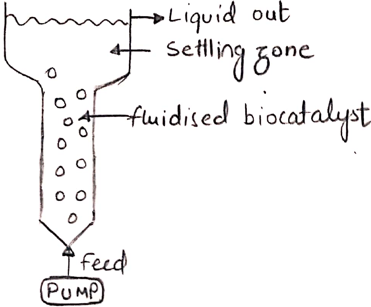
a) Tubular bioreactor
b) Christmas tree bioreactor
c) Foil bioreactor
d) Fluidized bed bioreactor
View Answer
Explanation: Fluidized bed bioreactor is comparable to bubble column bioreactor except the top position is expanded to reduce the velocity of the fluid. The design of the fluidized bioreactors (expanded to and narrow reaction column) is such that the solids are retained in the reactor while the liquid flows out. These bioreactors are suitable for use to carry out reactions involving fluid suspended biocatalysts such as immobilized enzymes, immobilized cells, and microbial flocs.
4. What type of perfusion bioreactor has been depicted in the following diagram?
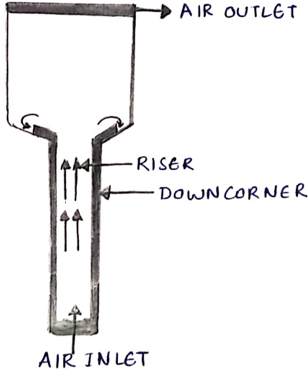
a) Parallel-Plate Bioreactors
b) Hollow-Fiber Bioreactors
c) Tower bioreactor
d) Spinner Flasks
View Answer
Explanation: A pressure-cycle fermenter with large dimensions constitutes a tower bioreactor. A high hydrostatic strain produced at the base of the reactor escalates the solubility of oxygen (O2) as the medium. At the highest point of the riser, (with extended top) diminishes strain and aids in the removal of carbon dioxide (CO2). The medium flows back in the down corner and completes the cycle.
5. What type of perfusion bioreactor has been depicted in the following diagram?
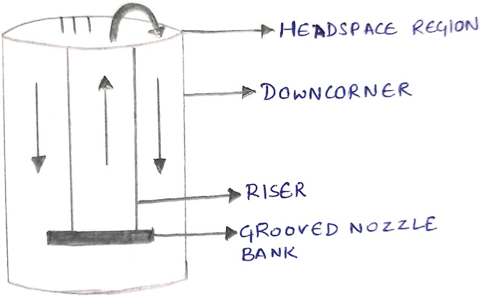
a) Tubular bioreactor
b) Christmas tree bioreactor
c) Airlift bioreactor
d) Rotating wall vessel bioreactor
View Answer
Explanation: In the airlift bioreactors, the medium of the vessel is divided into two interconnected zones by means of a baffle or draft tube. In one of the two zones referred to as a riser, the air/gas is pumped. The other zone that receives no gas in the down corner.
6. What type of perfusion bioreactor has been depicted in the following diagram?
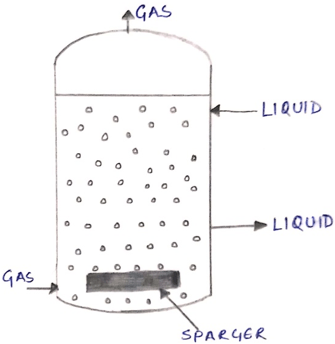
a) Parallel-Plate Bioreactors
b) Hollow-Fiber Bioreactors
c) Bubble Column bioreactors
d) Spinner Flasks
View Answer
Explanation: In bubble column bioreactor, the air or gas is introduced at the base of the column through perforated pipes or plates, or metal micro porous spargers. The flow rate of the air/gas influences the performance factors – O2 transfer, mixing. The bubble column bioreactors may be fitted with perforated plates to improve performance. The vessel used for bubble column bioreactors is usually cylindrical with an aspect ratio of 4.6 (i.e., height to diameter ratio).
7. ________ facilitate rapid dilution rates which make them resistant to both high pH and low pH volatile fatty acid wastes.
a) Continuous Stirred tank reactors
b) Christmas tree bioreactor
c) Foil bioreactor
d) Rotating wall vessel bioreactor
View Answer
Explanation: The continuous stirred-tank reactor (CSTR), otherwise called the tank or back mix reactor, or a continuous stirred-tank reactor (CFSTR), is a typical model for a concoction reactor in a synthetic building. A CSTR regularly alludes to a model used to evaluate the key unit activity factors when utilizing a ceaseless fomented tank reactor to achieve a predetermined yield. The numerical model works for all liquids: fluids, gases, and slurries.
8. What type of perfusion bioreactor has been depicted in the following diagram?
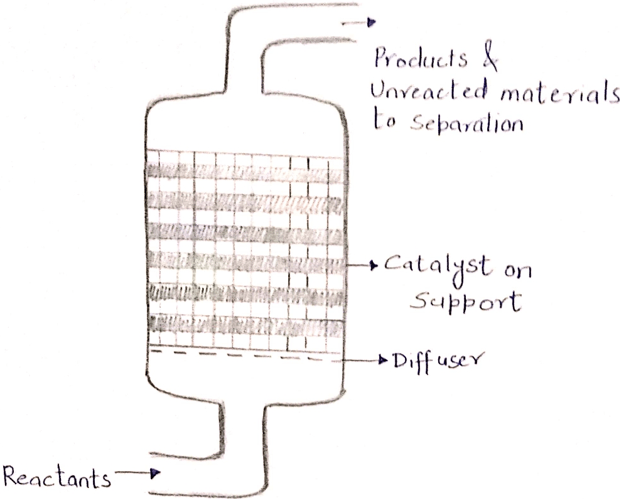
a) Continuous Stirred tank reactors
b) Christmas tree bioreactor
c) Packed bed bioreactor
d) Rotating wall vessel bioreactor
View Answer
Explanation: A bed of solid particles, with biocatalysts on or within the matrix of solids, packed in a column constitutes a packed bed. The solids used may be porous or non-porous gels, and they may be compressible or rigid in nature. Nutrient-broth streams consistently over the immobilized biocatalyst. The produce gained in the packed-bed bioreactor is discharged into the liquid and evacuated. While the progression of the liquid can be upward or descending, down-flow under gravity is favored.
9. ____________ bioreactor systems have length scales that are well matched to the physical dimensions of most cells and microorganisms.
a) Continuous Stirred tank
b) Microfluidic
c) Packed bed
d) Rotating wall vessel
View Answer
Explanation: Microfluidic bioreactor frameworks have length scales that are all around coordinated to the physical elements of most cells and microorganisms. In perspective on this, microfluidic bioreactors have appealing highlights which make them perfect to think about the conduct of cells and their interior association in their local microenvironment.
10. A ___________ landfill is a municipal solid waste landfill (MSWLF) in which liquids are added to help bacteria break down the waste.
a) bioreactor
b) open
c) packed bed
d) rotating wall vessel
View Answer
Explanation: A bioreactor landfill is a municipal solid waste landfill (MSWLF) in which fluids are added to enable microscopic organisms to separate the waste. The expansion in waste degradation and stabilization is practiced through the expansion of fluid and air to upgrade microbial procedures. This bioreactor idea varies from the customary “dry tomb” municipal landfill approach.
Sanfoundry Global Education & Learning Series – Tissue Engineering.
To practice Tissue Engineering Question Bank, here is complete set of 1000+ Multiple Choice Questions and Answers.
If you find a mistake in question / option / answer, kindly take a screenshot and email to [email protected]
- Practice Biotechnology MCQs
- Check Biotechnology Books
- Check Tissue Engineering Books
- Apply for Biotechnology Internship
